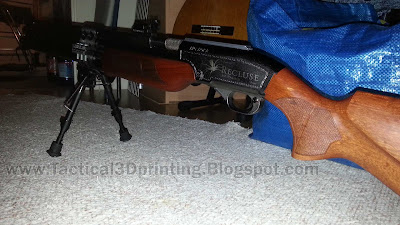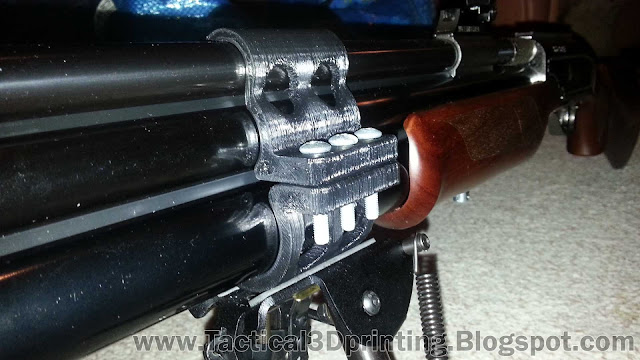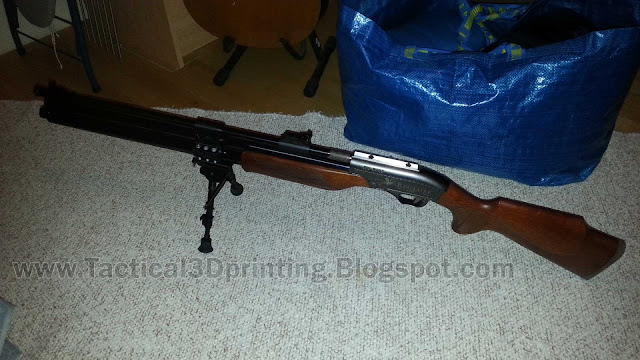Hi folks,
So yesterday I was in the chat over at GTA and and the guys over there were discussing a neat little product. I thought I could 3D print that, and we had ideas going back and forth. Check out the chat at
www.gatewaytoairguns.org and the product in question is at
http://ultimatesniper.com they have for sale called a Rifle Stabilizer.
 |
| Rifle Stabilizer by ultimatesniper.com |
They explain it like this:
"Competitive high-powered rifle shooters have long realized that the most
accurate shooting requires steadiness from skeletal support, while also
alleviating the tremors of respiration and heartbeat. The Rifle
Stabilizer's simple but sophisticated design addresses all three."
So the discussion in the chat was how could one make something similar. Really how hard could it be, it's a stick right?
PVC pipe or something out of aluminium would be ideal, however my concern was that PVC or similar thin plastic pipe would bend and not be able to hold the rifle steady.
Well it just so happened that I found a plastic handle and thought I could try and 3D print the thing. The length of the handle was 18 inch, that's around 46 cm and I figured that would be enough and the end was already threaded.
 |
| 3D Printing a Rifle Stabilizer Drawing And Print 1 |
The other end of the handle I figured I could use to attach it to a belt with a hook or something similar.
 |
| 3D Printing a Rifle Stabilizer Drawing And Print 2 |
Now the tricky part of this 3D print would be to get the threads right. And also have the right tolerances so that the 3D printed part would actually screw on once finished. And I'll explain more about this further on.
So off to the computer and do some 3D modeling!
My go to modeling software for 3D printing have always been Soildworks. It's such a powerful program, and I can not speak highly enough of it. Even though I have been using Solidworks since 2004 it's one of those softwares that only have changed slightly over the years. So even if you picked up an old copy from 2004 and had to jump over to the new 2016 version you would not feel lost. And seriously you would be able to do all the work needed in the 2004 version if it came to that.
 |
| 3D Printing a Rifle Stabilizer CAD Drawing Part Solidworks 1 |
So this is the part I came up with to fit the threaded handle I found. I measured I would need a 2 inch or around 52mm rest for my Sam Yang Recluse Air Rifle I'm using. And the threaded part of the handle measured in at around 20mm or 0.8 inch.
 |
| 3D Printing a Rifle Stabilizer CAD Drawing Part Solidworks Cross Section |
Here you can see a cross section of the part with the threads. I have found that plastic parts can have some weird looking threads and this handle is no exception. I measured the pitch to 4.5mm and the cut was done with a 3mm "ball" at the appropriate distance to get the desired thread cut. I also wanted to print without any support material so that's why there is a chamfer at the bottom of the thread. Filament 3D printers don't print well in open air!
 |
| 3D Printing a Rifle Stabilizer CAD Drawing Part Solidworks Cross Section 2 |
So this is where it starts to get tricky. I know from experience with 3D printing that you won't get parts that are 100% accurate to what you put in the modeling software. And the reason for this is
Thermal Expansion.
The plastic I print with is usually ABS (the same plastic Legos are made from) and the temperature the plastic comes out of the nozzle is around 220c. It depends on the plastic but usually around 220c when it gets put down on the printed part.
Anything that cools down starts to shrink and a plastic that cools from 220c to 20c is no exception. And that's why it gets a bit tricky. But as you 3D print more you learn how to compensate for this and the more you print the better you become I guess.
Trail and error with 3D Printing!
So is there a solution to the tricky part?
Yes!
- You can go and buy a 100.000 dollar 3D printer and be done with it
- Or you can do test prints before you print the whole part!
 |
| 3D Printing a Rifle Stabilizer Drawing And Print 3 |
I got close this time, really close on the first try. I did a 10mm test print of the threaded section of the part to test and see how the threads would fit and it screwed on.
The part was a little bit tight on the threads and I had to work it to get it to screw on. I felt that there was a little bit too much friction so I decided to make the thread cut 0.05mm larger and also 0.10mm larger overall.
 |
| 3D Printing a Rifle Stabilizer - Rostock Max White ABS 1 |
Here's my Rostock Max in action 3D printing the part. It only takes a few minutes to print a test part and make the adjustments, so once that have been done it's fingers crossed that the threads would come out as predicted. Of course I could have printed yet another test part to test if the threads would actually work but hey, I've been 3D printing for about 3 years now with this Rostock Max so I'm getting pretty confident.
The printer is a pretty stock Rostock Max with ramps running a bit higher voltage to help speed up the heating time of the heater bed. And I also have added cooling fans for the bed and 3d printer electronics and a heat shield for the extruder to keep the reflective heat from the nozzle away from the printed part.
 |
| 3D Printing a Rifle Stabilizer - Rostock Max White ABS 2 |
Almost done now, only about 50 more layers to go. Print time on this part was around 40 min. The settings I normally use for 3D printed parts that I want to finish quick are printed in 0.30mm layer height. This is a good compromise between speed and final quality of the printed part. Think about it, if I had used 0.15mm layer height the print time would have been 80 min instead.
I could have run a bit faster speeds with this white ABS plastic, but I find that 40mm/s with 55mm/s 90% infill is the sweet spot when I print with 222c extruder temp and 0.30mm layers. It gives you strong parts with good layer bonding. I have been using Cura 14 for slicing the last couple of months now and I find that it works pretty well, but I did have some issues with the latest release of Cura so I will stick with the one that works best for me for now.
All done!
 |
| 3D Printing a Rifle Stabilizer Finished Part 1 |
So here is the finished part, I only did a bit of cleaning on the part to take off the brim lines (this helps the printed part to stick to the bed when printing so they don't go flying off on you). I was a bit lazy and I used a grinder to put a chamfer on the end. It's quick and it turns out better than using a file or knife.
This picture shows how the threads turned out, and it looks pretty good for a 0.30mm layer height..
So did it work?
 |
| 3D Printing a Rifle Stabilizer Finished Part 2 |
Here it is, the finished 3D printed Rifle Stabilizer. And yes the part screwed on really nice and it turned out really well. And it's the right size for my Recluse.
So did it really work as a Rifle Stabilizer?
Well no, actually when I gave it a try the overall length is a bit too short for me and 18 inches is not enough for me to get a level shoot with my rifle. It would work if I was aiming down a slope, but it's too short when I have it resting on my hip like in the picture. I would have to add a few more inches to the handle for it to work like it should and give me a level shoot.
But that's the thing with this Rifle Stabilizer, it needs to be adjustable in length. So now I only need to figure out the best way to get it adjustable. Or perhaps it could be done with a belt that you have around your waist. Either way it's a proof of concept and I can also confirm that a PVC pipe would be rigid enough to use if someone can figure out a way to get it adjustable.
Comment, Share, like, Subscribe, Thumbs up, or Thumbs down if you hate it!
If you like this also check out my recent post

































